Benefits and challenges of modular construction
27 August 2021
Andy Brown explores whether the industry is prepared to embrace modular construction and the numerous advantages including sustainability.
The construction industry has, to some extent, moved with the times in terms of new technology, health and safety rules as well as new equipment. However, could it be doing more to exploit modern industrial techniques, such as modular construction?
While there are many more moving parts on a construction site than a car factory assembly line for example, it is also true that a car assembly plant in 2021 looks nothing like it did a hundred years ago back in 1921. Yet construction sites have not changed anywhere as much.
According to the Modular Building Institute, modular construction can be defined as a process in which a building is constructed offsite, under controlled plant conditions, using the same materials and designed to the same codes and standards as conventionally built facilities – but in about half the time.
Buildings are produced in modules that, when put together onsite, reflect the design intent and specifications of the most sophisticated site-built facility.
Advantages of modular construction
Modular construction is certainly not new. Builders in the United States began selling ‘kit homes’ in the early 1900s, with European governments turning to offsite construction after the Second World War to address housing shortages.
Willem Otter, managing director of BAM Specials, which incorporates various business units including modular building specialist HSL, said that BAM has been producing modular housing concepts for 25 years. However, he acknowledged that modular construction is becoming more popular.
Otter explained, “A large part of these concepts is based on modular elements, which are produced offsite. This applies to both new build and renovation projects.
“Modular production has become more important, because regulations, requirements and ambitions are becoming ever higher in order to reduce carbon emissions, particulate matter and nuisance for local residents.
“To realise these ambitions, BAM has invested to make its production processes increasingly modular. The affordability of housing is also increasingly urgent.”
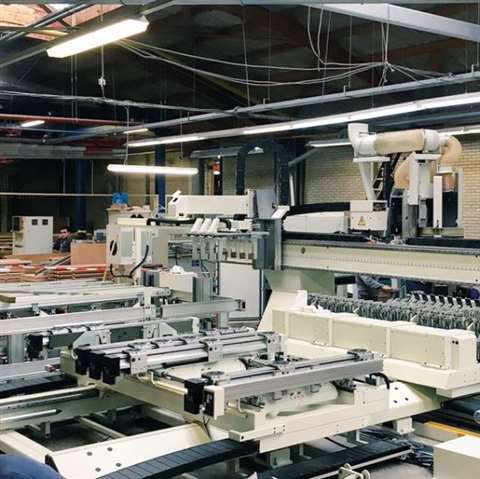 The factory-controlled process generates less waste and creates fewer site disturbances
The factory-controlled process generates less waste and creates fewer site disturbances
One of the biggest advantages of modular construction is that, because it occurs offsite, it can be done under controlled conditions and offers advantages in terms of health and safety as well as working conditions. It also can have a serious impact on the bottom line for contractors as it can save substantial sums of money.
David Harris, managing director of Premier Modular, agrees that the sector is rapidly developing.
He said, “Modular construction is definitely a growing trend. Demand for our modular solutions is rapidly rising year-on-year and there are a number of drivers.
“There is little difference in the cost of offsite compared to in-situ construction. However, modular solutions have financial benefits by ensuring earlier occupation for a faster return on investment, earlier revenue generation and greater certainty of delivery on budget.”
Is modular construction cheaper?
While modular construction can save costs, it is not necessarily as straightforward as that. The price of raw materials and staff will be the same as building onsite, but there is the added cost of transportation of the materials when finished and of course crane installation.
Gary Buick, director at Pick Everard – a consultancy practice working within the property, infrastructure and construction industry – commented, “To achieve overall cost benefits, use of standardised modules in volume is required, which will realise improved production rates and buying enhancement on raw materials.”
As is the case with all industrial processes, the more standardised and larger in scale, the higher the cost savings.
Otter agrees and remarked, “Modular production results in a reduction in cost price. The major reduction in the cost price of housing lies in the challenge of whether the construction industry is able to organise the production process with variations and individualisation in the same way as the car industry.
“When modular factories can robotically produce ‘smart parts’ through standardisation in connections and solutions, the cost of housing can be substantially reduced through scale and elimination of preparation costs.”
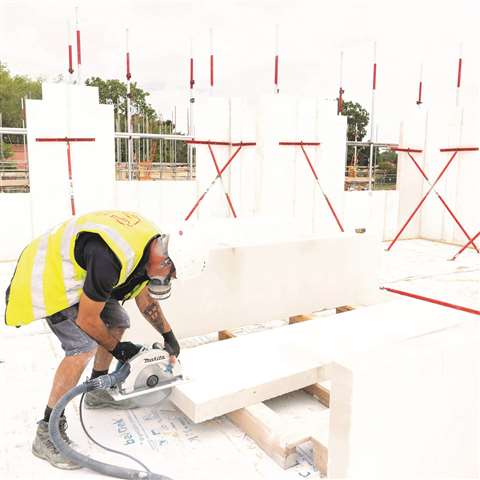 Modular construction requires less labour, important due to global labour skills shortage
Modular construction requires less labour, important due to global labour skills shortage
Construction’s labour shortage
The shortage of skilled workers is an issue that has dogged construction for years and the use of new technology, such as automated equipment, is viewed as one way of getting around the problem as is modular construction.
Paul Terry, managing director of Roofspace Solutions, stated, “According to the Royal Institute of British Architects, MMC [Modern Methods of Construction] such as modular construction or panellised solutions, can reduce the number of employees required on a construction site by up to 70 per cent and cut overall building costs by 20%-40%. Productivity benefits could save the United States and Europe US$22 billion annually by 2030.”
Harris declared, “The shortage of skilled labour is now even more severe following Brexit and the Covid-19 pandemic, which means more clients and contractors need to turn to offsite solutions to achieve greater certainty of delivery on time and on budget.”
As well as addressing a shortage of skilled workers, modular can also help improve health and safety. As all work is taking place in one location it can be more of a controlled environment.
This lack of skilled workers is a global trend in numerous industries, although modular construction can help with the even bigger trend of sustainability. Governments across the globe have committed to reducing their carbon emissions, with building and construction a key component in whether these targets are met or not.
Modular construction helps to cut down on waste because everything is made to order, materials waste is minimal. Increasing numbers of those involved in modular construction are incorporating recycled materials into the process.
Harris said, “The drive to net zero presents enormous opportunities for offsite. Modular solutions are a simpler route to achieving low or zero carbon construction and manufacturers need to be leading the way in this area.”
Put simply, less energy and time is required to produce a building away from a site, which makes it more sustainable.
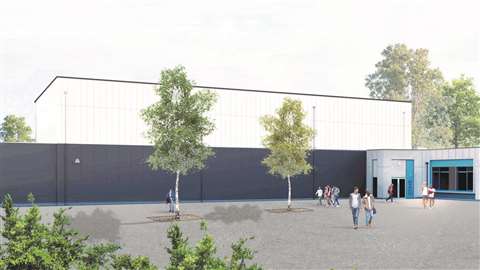 Certain sectors, such as schools like Clacton County High School, are suited to modular construction
Certain sectors, such as schools like Clacton County High School, are suited to modular construction
Cost of modular construction
There are still challenges with modular construction. It has to be done on a certain scale and size to be profitable and therefore needs substantial investment. There is reduced flexibility as everything is the same size, so it can be difficult and expensive to transport the finished products to sites.
Buick explained, “The growth trend in modular construction is sector sensitive. Certain sectors like healthcare, housing and education are set to see increased adoption of modular and other modern methods of construction.
“There has been a particular emphasis on offsite manufacturing for residential housing, which is best evidenced with the investment from Legal & General’s modular housing factory – the largest advanced manufacturing facility for modular homes in Europe. This facility will annually produce around 3,500 new homes at its peak.”
However, despite challenges, proponents of modular construction point to its green credentials, the potential for financial savings, increased speed of production and it not needing as many workers as easily outweighing the negatives.
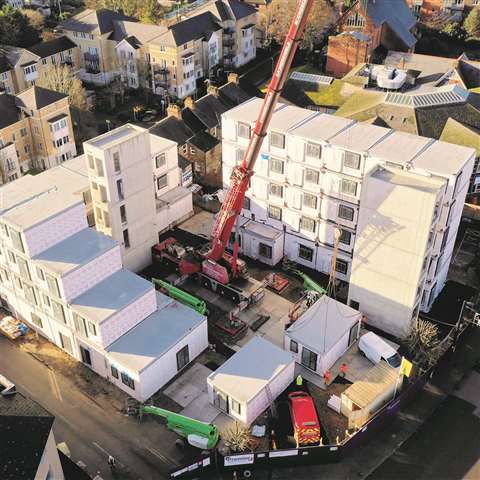 Transport and crane hire are extra costs associated with modular construction such as Premier Modular’s project Desborough Road
Transport and crane hire are extra costs associated with modular construction such as Premier Modular’s project Desborough Road
The global pandemic has touched all areas of life, including that of the construction of buildings.
With working from home looking likely, to some extent, to be a trend that is here to stay then will the same number of office blocks be needed in the future? Will the same transport links to get people from their homes into city centres be required?
Harris added, “Looking forward then buildings will need to be more flexible and adaptable to change, presenting tremendous opportunities for modular construction.
“There are huge lessons to be learned from Covid-19, which highlighted the need to make facilities more interchangeable and futureproof.
“Offices can become hospital wards or buildings may need to be relocated to different sites to meet changing local needs. This means assets will be considered differently while still needing to meet the same standards for build quality and comfort.
“We believe more buildings will be leased to reduce capital expenditure and, after the leasing period, modular facilities can easily be removed, relocated, reconfigured or refurbished.”
Modular building certainly offers a degree of flexibility that conventional construction cannot.
With governments around the world likely to put increasing pressure on the construction industry in their country to reduce emissions, the usage of modular construction is surely only going to increase. There are simply too many reasons in its favour.
Terry said, “Looking ahead, factors such as worldwide construction labour shortages, high housing demand, supply chain restrictions,and regulations will likely enable these methods to thrive. Building technology will increase the labour demand of construction per unit, and more complexity in design will rely more on off-site approaches to ensure quality.”
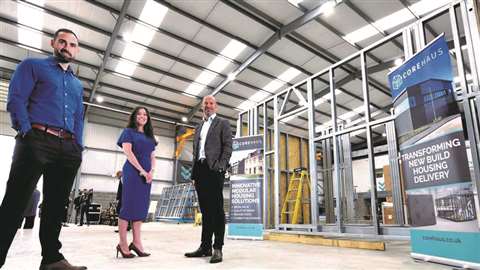 CoreHaus is one of the newest modular housebuilders in the UK
CoreHaus is one of the newest modular housebuilders in the UK
UK modular housing manufacturer CoreHaus has opened its first manufacturing facility and begun full production of its steel-framed modular homes.
One of the UK’s newest modular housebuilders, comprising a joint venture made up of Carlton & Co Group and public procurement specialist Fusion21. Corehaus said that its new 1,850m2 facility will use Modern Methods of Construction (MMC) to more quickly build houses that offer lower energy bills.
Scott Bibby, managing director of CoreHaus, explained, “Our light gauge steel-frame system ensures that CoreHaus can be used in both urban and rural locations with elevation treatments tailored to suit each setting, providing almost unlimited design potential. The standardised modular core means the solution can be configured for homes of almost any size.”
With an existing order book valued at around £6 million (US$8.2m), the manufacturing plant will initially supply units to regional housebuilder Homes by Carlton, as well as a national social enterprise charity. With demand for housing is currently outstripping supply, the company expects to increase annual production to around 1,000 units a year.
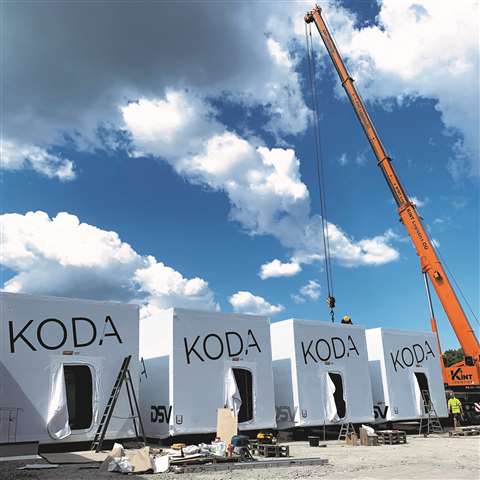 Four KODA houses prior to loading. Photo: Kelli Roosimägi
Four KODA houses prior to loading. Photo: Kelli Roosimägi
German real estate company hanova WOHNEN GmbH has set up a rental housing project in the form of KODAs, a type of modular and moveable house from the company Kodasema, in the heart of Hannover.
Birgit Linnamäe, CEO of Kodasema, stated, “This is a remarkable example of international private-municipal collaboration while addressing the pressing issue of housing shortage in an innovative and sustainable way. We believe that this will lead to many even larger scale KODA Community housing projects across European cities,”
Kodasema, founded in 2013, revealed that the turnaround is very quick at approximately one year from project initiation to tenants moving in.
Shifting from onsite construction to offsite prefabrication is increasing in certain markets. For example, in Scandinavia 45% of all housing is being built using offsite manufacturing in some capacity, and the permanent modular construction market share of new North American real estate construction projects has grown by 50% from 2015 to 2018.
Linnamäe added, “To a significant degree the development of the sector depends on the private and public sector working together. This needs to happen to ensure sufficient housing is provided quickly, where people need it most.
“But the development of new areas using modular housing means services – such as schools, healthcare and childcare are developed and redensification – does not put a strain on the services available to the existing community.
“As the housing crisis worldwide has become a significant problem then the only solution to quickly address this issue is to mobilise factory construction and quick installation of affordable homes.”
STAY CONNECTED



Receive the information you need when you need it through our world-leading magazines, newsletters and daily briefings.
CONNECT WITH THE TEAM








